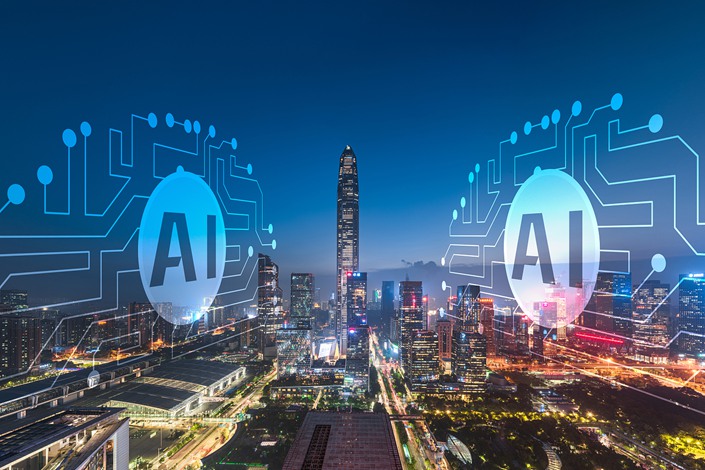
The rivalry that has been simmering between China and the United States, the world’s two leaders in developing artificial intelligence (AI) technology, is now nearing the boiling point as the two countries’ lines of battle become drawn ever more clearly in policy documents, white papers and intelligence bulletins.
The U.S. has advantages such as leading hardware, research, and talent, whereas China has unparalleled masses of AI-ready data at its disposal to drive technological development, a strong will to succeed in its quest for primacy, and a head start in its already widespread deployment and adoption of many digital technologies.
Since 2017, China has been producing more AI scholarly research than the U.S. But in 2020, for the first time, China also surpassed it in AI-related journal citations, according to last year’s Stanford University AI Index Report.
“Citations measure whether the ideas you’re putting out are novel and have impact — not just that you have a lot of researchers pumping out publications,” said Michael Sellitto, Stanford University Human-Centered Artificial Intelligence deputy director and a member of its AI Index steering committee. “The data suggests that China is making more contributions to basic AI knowledge now, a qualitative improvement,” per the Stanford report.
“I don’t think they’ll be number one, because I think there’s still a level of genius and creativity in Silicon Valley that persists and will always persist,” Breyer Capital founder Jim Breyer told CNBC, likening the two superpowers’ AI rivalry to the U.S.-Soviet space race of the 1950s.
In June 2020, San Francisco-based independent AI research lab OpenAI announced the launch of its GPT-3, the third generation of its massive Generative Pre-trained Transformer language model, which can write computer code, poetry, and everything in between, various media reported at the time.
Billions to Trillions
A year later, with considerably less ballyhoo, Tsinghua University’s Beijing Academy of Artificial Intelligence unveiled an even larger model, Wu Dao 2.0, with 10 times as many parameters — the neural network values that encode information. GPT-3 has 175 billion parameters, whereas Wu Dao 2.0’s creators claim that their model has 1.75 trillion. Not only can it generate text as GPT-3 does, but it can also generate images from text descriptions like OpenAI’s 12-billion parameter DALL-E model. Furthermore, it has a scaling strategy that is similar to Google’s 1.6 trillion-parameter Switch Transformer.
Even as AI thus fuels the rivalry between China and the U.S., it also is driving the two countries far ahead of the rest of the world in innovation, economic growth, and national power, according to the Brookings Institution, a think tank based in Washington.
China’s official statements promoting the military-civil fusion of technological development to erode America’s competitive edge also prompt unease, which is further amplified by China’s grand trillion-dollar Belt and Road Initiative (BRI) infrastructure program that spans nearly 140 countries and is central to its plan to extend its global influence. The Digital Silk Road (DSR) is a key component of the BRI and seeks to reach into the digital sphere through the DSR’s main assets — fifth-generation wireless network communications technologies, mega data centers, AI, and satellite navigation systems — all of which have critical ramifications for data privacy, national security, and global cyberspace governance, and which will endow the Chinese with the power to access, analyze, and exploit the data of BRI recipient nations.
Some worry this will also enable China to set global technological standards, according to Brookings. China’s actions have fed what Dean Garfield, president and chief executive of the Information Technology Industry Council, has denoted as a new “hysteria” in Washington that America is ceding its innovation edge to China.
Apropos of which, ex-Secretary of State Condoleezza Rice also said, “When we see [China]... say, ’We’re going to do whatever it takes to surpass the United States’... you’re going to get a response from the United States,” per the Brookings report. Much of that response has been seeking to slow or arrest China’s progress by tightened screening of foreign investments in core technologies, scrutinizing academic exchanges, imposing tariffs to reduce China’s competitiveness in key sectors, increasing prosecutions of Chinese for economic espionage, and greater investment in counterintelligence.
Arguments for ’decoupling’ the economic relationship between the U.S. and China by collapsing ICT supply chains would do just that. The U.S. technology sector is deeply intertwined with China’s, with high-level collaboration between researchers and engineers and rising tallies of co-authored academic papers, and joint investments by U.S. and Chinese venture capital firms into AI-related firms in both countries, Brookings said.
Civil AI
In AI implementation in the civil sphere, China has greatly outpaced the West, open media platform China-U.S. Focus reported last month. China instituted its Social Credit System in 2014 to monitor ordinary citizens and confer benefits or restrict privileges. The system is run on facial recognition and big data analysis powered by AI algorithms.
China’s device market is also driving innovation, most notably in smartphones, cameras, robots, wearables, smart speakers, automotive, smart mirrors and computer processors.
With respect to U.S.-China competition in the AI space, many U.S. officials, among them Nicolas Chaillan, ex-chief software officer of the Air Force, fear the U.S. may lose the AI race against China because the U.S. is not funding critical AI projects as aggressively, per the China-U.S. Focus report. In comparison to the more centralized Chinese research and development (R&D), most innovation in the U.S. occurs in the private sector and is not directly aided by the government. This ’decoupling’ or disconnect often creates delays and information gaps. The U.S. still leads in military AI, but this may soon change as China continues to propel innovation with big data, digital surveillance, and cloud computing.
The U.S. holds leads in talent, research, development, and hardware, while China surpasses in implementation, as well as data quantity and quality, but in recent years China has succeeded in slowly leapfrogging the U.S. and seems well positioned to overtake it in future. The first country to acquire an AI ’strategic weapon’ will have a huge advantage in both security and the global economy, per the report.
China’s cabinet, the State Council, announced a bold plan to push its AI sector in 2017, aiming to make the country the world’s “major AI innovation center” by 2030. The slew of policies that various government departments have since issued on that basis have now coagulated into the edifice of the nation’s AI governance and support infrastructure.
The declaration of this audacious manifesto has galvanized the U.S. into action. Its Congress set up the National Security Commission on Artificial Intelligence the following year, citing the speed with which China has caught up with the U.S. “For the first time since WWII, the U.S.’ technological predominance —America’s technological predominance — the backbone of its economic and military power — is under threat [emphasis in original],” the legislative body said.
Read more Kai-Fu Lee: The Real Story of AI
Clearing hurdles
In its quest to become what Forbes termed the “first global superpower for Artificial Intelligence,” China aims to infuse transformative technology throughout industry, administration and defense by that year. China is second globally in AI after the U.S., though it must still find ways to overcome a raft of impediments such as a dearth of talent and a still-limited ability to create AI microprocessors. It is also hindered by a preoccupation with applications that generate a quick return, rather than core technology that yields a greater long-term bounty, but requires higher initial investments. The government’s elaborate blueprint now seeks to surmount all these obstacles.
The East Asian giant’s AI initiative has sown consternation in both the U.S. and the European Union, who are now surveilling its AI developments with ever greater scrutiny. The framework is being erected against the background of the economic initiatives President Xi Jinping proclaimed in 2013.
“High-end sci-tech is the sharp weapon of modern countries,” Xi said in a speech. “Since modern times, one important reason why Western countries have been able to dominate the world is their mastery of high-end science and technology. True core technology cannot be bought. ’The sharp weapon of the state cannot be shown to others,’ as the saying goes. Only with strong scientific and technological innovation capability can we improve China’s international competitiveness.”
The State Council issued its ’Notice of New Generation AI Development Plan’ on July 20, 2017, pinpointing key objectives to be reached by 2020, 2025, and 2030. China is to achieve “world-leading level” by 2025 and become the “major AI innovation center in the world” by 2030, with AI as “the main driving force of China’s industrial upgrading and economic transformation,” per the framework.
By 2030, China’s AI sectors are to be more than three times bigger than they were in 2020, the roadmap directs, with the scale of associated sectors to more than quintuple.
“There’s no doubt China sees AI as one of the critical technologies of this era and wants to match the United States,” said Jeffrey Ding, a doctoral researcher at the University of Oxford who studies Chinese AI. “The hype over China as an AI superpower poised to overtake the U.S. is certainly overblown. The U.S. maintains structural advantages in the quality of scientific and technological inputs, the fundamental layers of the AI value chain, and key sub domains of AI (such as computer vision, predictive intelligence and natural language processing).” If the total global AI capacity equals 100 points, the U.S. has 33 points and China 17, Ding noted, tech news platform GadgetSay reported in March 2020.
Topping the charts
During the period of its latest Five-Year Plan (2021-2025), China’s expenditures on research and development (R&D) are set to climb by over 7% yearly up to 2025.
China was also No. 1 globally in 2020 in AI research papers and patents. The scale of its domestic market and the initial lack of a definitive regulatory regime to safeguard privacy have both boosted the country’s swift progress in AI, per a European Parliament report published in September.
As mentioned earlier, one key impediment to China’s avowed goal of becoming the world’s premier AI power by 2030 is a relative dearth of talent. China was home to the second-largest pool of AI scientists and engineers by the end of 2017 — some 18,200 — but this was still significantly less than in the U.S., which had about 29,000 at the time. The country also ranked a mere sixth in terms of its tally of ace AI researchers, according to the 2018 China AI Development Report published by Beijing’s prestigious Tsinghua University.
Another major obstacle is that a great deal of China’s AI talent goes abroad to acquire its expertise and tends to stay there. One strategy underway to lure these highly skilled elite practitioners back home is for AI institutes to offer plush salaries that can be up to two or three times those of other professors, e.g., at the Institute of Artificial Intelligence and Robotics at Xi’an Jiaotong University, according to its founder and director, Zheng Nanning, as U.K. science journal Nature reported in August 2019.
China thus seems to have concocted a consummate cocktail of AI policy to attain its lofty goals, and its ace in the hole in its titanic contest with the U.S. for supremacy in the AI sphere will doubtless prove to be its centralized planning, ability to mobilize resources at the national level, and its teeming masses, not to mention its burgeoning commercial AI sector, whose ability to create and innovate is often underestimated.
It is natural to think of the China-U.S. AI rivalry as a zero-sum game. In some ways this is certainly the case, but there are also many powerful incentives for the two countries to cooperate and work together where possible. Examples include fighting climate change, preventing and containing pandemics, averting terrorist attacks, and other areas in which the two countries’ interests closely align.
Win-win
The notion that building AI capabilities is a race or competition is also misleading since the ever-evolving field of AI has no fixed endpoint or final destination. For both countries to come up with a mutually agreed set of laws, rules, and regulations governing the use of AI will thus be crucial, as will doing this in tandem with the rest of the international community. This should reduce the likelihood of a miscalculation or misunderstanding, guard against the misuse of AI technology, and strengthen common defenses against cybercrimes.
Flexibility will also be key, given the need to adapt to an ever-changing terrain and to adjust policy as necessary. It is also important to not be fearful of change or new technology in and of themselves, and to recognize that “technology and AI itself have no values, no right or wrong,” according to Xia Huaxia, general manager of Meituan Dianping’s AI platform. If used responsibly to maximize benefits while minimizing risks, AI will still do far more good than harm, and deciding to do nothing or to limit certain AI applications while competitors and rivals race ahead likely carries even more risk.
Ben Armour is a correspondent and Jack Kotin is a contributor at the Yuan, a new tech community platform focused on artificial intelligence in health care, machine learning and related disciplines.
The content herein is subject to copyright by The Yuan. All rights reserved. The content of the services is owned or licensed to Caixin Global. The copying or storing of any content for anything other than personal use is expressly prohibited without prior written permission from The Yuan, or the copyright holder identified in the copyright notice contained in the content.
The views and opinions expressed in this opinion section are those of the authors and do not necessarily reflect the editorial positions of Caixin Media.
If you would like to write an opinion for Caixin Global, please send your ideas or finished opinions to our email: opinionen@caixin.com
Get our weekly free Must-Read newsletter.







